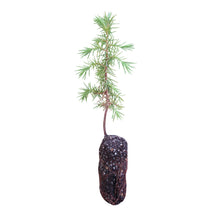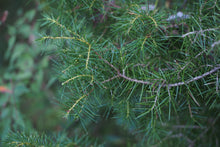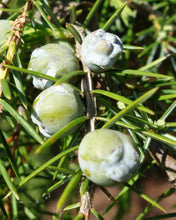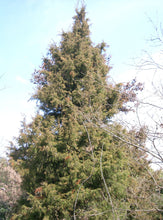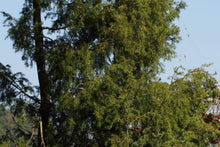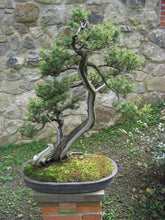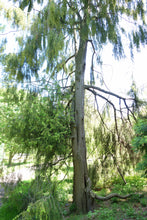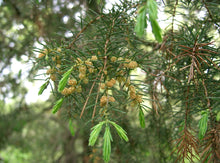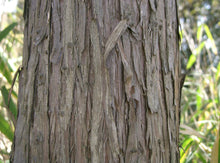
Juniperus rigida
- A mystical native of Northeast China, Southeast Russia, Korea, and Japan, often discovered at temples and other consecrated sites
- 100% guaranteed
- Seed-grown on California's Redwood Coast
- Transplanting and care instructions included
 |
Moisture Dry to Medium |
 |
Cold Hardiness -20°F |
 |
Light Full Sun |
 |
Size 15 – 40' tall / 10 – 20' spread |
 |
Lifespan 500 yrs |
 |
Growth Rate Medium |
 |
Drought Tolerance High |
 |
Wind Resistance High |
About Temple Juniper
An elegant formation of trees dripping with whorls of spikey-looking needles spices the air with a resinous musk, silently ushering the sojourner toward the stone portal of a Korean shrine. That same peppery fragrance scents the air surrounding the ruins of an ancient temple in Outer Manchuria and consecrates the gardens and grey stones of a temple in Japan. What is spicing the air in these sacred places? This is the rare Temple Juniper, Juniperus rigida, a mystical native of Northeast China, Southeast Russia, Korea, and Japan, often discovered at temples and other consecrated sites, and rarely found in cultivation elsewhere.
Juniperus rigida, known commonly as Temple Juniper or Needle Juniper, is an uncommon tree, usually small-to-midsized, with an open habit and lissome, flowing branchlets filled with sharp needles arranged in charming whorled trios. Temple Juniper is one of about 60 members of the Cypress family (Cupressaceae), and is closely related to the Common Juniper (Juniperus communis) and Shore Juniper (Juniperus conferta). This species was first scientifically documented in the mid-1800s, and was brought to North America around 1915.
Temple Junipers are slow growers that can be quite variable in their appearance, from broad, irregular shrubs to symmetrical, strongly vertical trees with weeping foliage. Generally, Temple Junipers take on an upright form with a vertical central leader and strong horizontal, or even ascending, branches which anchor the tree’s cascading foliage. Temple Junipers typically range in height from 15 to 40 feet tall, with a spread of 10 to 20 feet. The tallest known Juniperus rigida in the wild is approximately 60 feet tall. Temple Junipers have stout grey trunks, wrapped in fissured, peeling bark. The tree’s bright yellow-green needles are sharp, but not as prickly as many junipers, and each one is adorned with a single stomatal band on the upper surface. This unique foliage gives the Temple Juniper its other common name: Needle Juniper.
Temple Junipers are dioecious, meaning each tree has its own gender; male and female trees have different reproductive anatomies. The yellowish male “pollen cones” form, shed their pollen into the wind during spring, and then fall off the tree. Female seed cones are often called “berries” because they appear very berry-like and showy. The small, plated seed cones add a lovely visual element to the tree’s texture. The berries emerge green, and mature on the female tree for about two years, ultimately becoming a dark, waxy purple-black. Birds love to eat these berries, and play a huge role in dispersing the tree’s seeds, which pass on through after the bird digests the fleshy exterior scales of the berries. Temple Juniper berries are also edible for humans, raw or cooked, and are said to have various medicinal properties. The berries can also be dried and ground into a delicious spice.
Temple Junipers are extremely hardy trees that can grow virtually anywhere — from seashores to mountaintops to cityscapes. Normally found in dry mountain areas, this tree is cold hardy to -20°F and can take blazing heat as well. Temple Junipers perform really well in cities, as they are largely impervious to urban air pollution. Sometimes called the “camels” of the tree world, Junipers can flourish in extremely dry, hot regions with very little water. A Temple Juniper literally cannot get too much sun, but shade is another matter, and should be minimized. Also, while Temple Junipers can grow in almost any soil type, they cannot tolerate any location with a surfeit of moisture. So, rule number one for this tree is avoid wet planting sites and go for a full-sun location.
In addition to being a fine small-to-medium sized specimen tree for yard or garden almost anywhere, Temple Juniper is a highly sought-after tree for bonsai. In China, Korea, and Japan, in particular, people also love the wood of Temple Juniper for furniture-building, carving, and other artcraft.
About Jonsteen's Seedlings
All of our trees are seed-grown at our nursery on California's Redwood Coast, which is inspected monthly and licensed by the California Department of Agriculture. Trees can provide a natural barrier against high winds, temperatures, noise pollution and soil erosion, all while benefiting local air quality, wildlife and property values — a Jonsteen seedling will only grow in value and beauty!
About Jonsteen's 100% Guarantee
All of our trees are guaranteed to arrive healthy and in good condition. If your tree perishes despite your honest efforts, we will be happy to replace it with a small-sized seedling for just the cost of shipping/handling. You can learn more about our guarantee and tree replacement policy here.
Seedling Size Chart: Medium
Due to the dynamic nature of actively growing trees, as well as the tremendous variation between species’ growth rates, we rely on the cubic volume of a seedling’s root mass to determine its “size” (Small / Medium / Large / XL). Within each size there is minor variance — the dimensions provided here represent the category minimum. If exact measurements are essential, please contact us about current stock.










